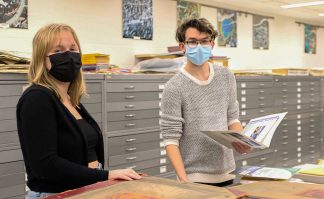By Allison Campbell-Jensen
Student employees are essential in the John R. Borchert Map Library, located two levels below ground in Wilson Library. They help accomplish projects that move the collection of maps, atlases, aerial photographs, and more into formats, the catalog, and storage that can be searched by users.
Marshall Mabry, a senior majoring in urban studies, and Lauren Boyer, who is majoring in English and Sociology, have each worked in the Borchert Map Library for more than two years. They each can work independently and are trusted by Student Supervisor Dana Peterson to help train other students.
“Marshall and Lauren are both really special,” she says. “They do a really nice job modeling for the other student staff.”
The student employees in the Borchert Map Library need to have good customer-relations skills to meet the public, Peterson says, and “they have to be able to figure out geography-based questions and research, even if that is not their major.”
They also need to learn Library of Congress classifications for books and maps, how to scan maps for patrons, and to help with printing. Because the Borchert Map Library receives relatively few in-person visits, they also need to be prepared to work on projects.
Digitization project
“This is the longest I’ve ever stayed in a job, partially because of the people I get to work with. I enjoy every one of them. It’s nice to have the connections.”
—Marshall Mabry
Pulling maps created before 1930 keeps Mabry busy with a Map Library digitization project.
“I go through shelves and drawers of maps, find what we’re looking for, search for what I can’t find, and solve problems,” he says. “There are a lot of inconsistencies in the records because of years of different catalogers and different styles and approaches. We’re trying to get everything uniform and up to date with our records.”
He sends them to Digital Library Services to be scanned, uploaded, and made accessible through UMedia — a Libraries website that provides open access to nearly 200,000 digitized materials from across the University of Minnesota.
Along with maps of Minnesota, there are maps of areas from around the world.
“Each map is logged to a certain portion of the earth, so you search for a term or an area or a region and those maps will be more accessible because they have these tags,” Mabry says. In addition, he and other staff can refer interested patrons to these digitized maps online.
With this digitization project, he’s helping to add 150 maps a month, “some of it really rare stuff that wouldn’t be very accessible otherwise.” There are pre-1600 maps of the world that are beautiful and colorful but don’t show the continental shapes we expect today. “It’s neat to see with those how our cartography and our understanding of the world has changed,” he says.
Filing, searching, and preserving work
Once the maps come back from being digitized, they are refiled by Boyer. “We have hundreds of maps leaving and coming back,” Peterson says, and Boyer has a knack for keeping everything orderly.
During the time of quarantine for COVID, Boyer took on a project to check into a backlog of donated maps to see if they were already owned by Borchert Map Library. She would search for the maps in the catalog, which is not easy because many maps don’t have dates or don’t have them where you expect them, and some maps have more than one title.
“She just became so skilled at finding things that I was very impressed,” Peterson says.
“Tasks that seem mundane are actually really important when you look at the big picture,” Boyer says. Protecting fragile maps by encapsulation in plastic is one. “Knowing that years down the line, that the map will hopefully last longer and be looked at longer because something I did that kept it preserved — I think that’s kind of cool.”
Aerial photos and topo maps
An even longer-term project of about 12 years has been processing slides, 35mm film in 2” x 2” holders, of aerial surveys. County-based farm agencies sponsored aerial surveys throughout the state; some came to the library organized, others had been thrown into bags, Peterson says. Borchert Map Library student workers have been sorting them by county, township, and section numbers (there are 36 sections in a township). They add the year and then label each slide, putting them in order.
The student workers have gone through about 425,000 slides. “We might be done with that project in two or three years,” Peterson says.
Making accessible topographic maps from the U.S. Geological Survey was a major accomplishment by students. There are 53 sets and some sets have up to 4,000 sheets. They had not been cataloged as sets and there were no item records for the sheets.
“Our students did spreadsheets listing every sheet for every state and territory that we had,” Peterson says. She worked with library staff to get the items cataloged. “I think it was close to 80,000 items that were added in this way. That’s completely the work of our student staff.”
Mutual regard
Peterson says the student employees at Borchert Map Library “really are kind of extraordinary.” After Mabry and Boyer graduate in spring 2022, they will have warm memories.
“This is the longest I’ve ever stayed in a job, partially because of the people I get to work with,” Mabry says. “I enjoy every one of them. It’s nice to have the connections.”
Boyer appreciates her experiences in the Borchert Map Library.
“It’s been three years now. It’s been kind of a stable environment compared to other things going on in the world.”






Thanks for the walk down memory lane! Having spent three decades of my life in the Borchert Map Library, I’ve always been fond of the place and all those who have kept it one of the gems of the Libraries!